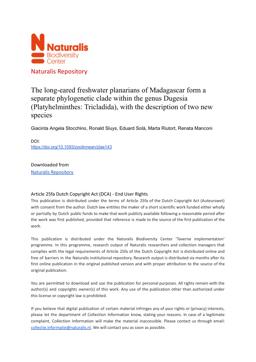2024-12-07
The long-eared freshwater planarians of Madagascar form a separate phylogenetic clade within the genus Dugesia (Platyhelminthes: Tricladida), with the description of two new species
Publication
Publication
Zoological Journal of the Linnean Society , Volume 202 - Issue 4
Madagascar and the Comoros Archipelago are inhabited by freshwater planarians of the genus Dugesia characterized by a unique morphotype with long and pointed auricles, which were traditionally ascribed to only one species, Dugesia milloti. Collections of new specimens of these long-eared freshwater triclads enabled us to examine these worms in more detail than previously had been possible and, thus, we were able to study the animals from an integrative perspective, including morphological, karyological, and molecular data. In addition, we re-examined D. milloti specimens that were available from natural history collections. In contrast to previous notions, we found that at least seven species of long-eared planarians inhabit the Malagasy inland waters, two of which are here newly described, viz., Dugesia crassimentula Sluys & Stocchino, sp. nov., and Dugesia insolita Stocchino & Sluys, sp. nov. Molecularly, the long-eared planarians form a separate phylogenetic clade that is not closely related to the other distinct morphotypes of Malagasy congeners. Furthermore, our karyological analyses revealed a new haploid (n = 5) chromosome number for the genus Dugesia, being the lowest chromosome number presently known for this genus. In addition, a previously unknown autotomy-like behaviour in freshwater triclads is reported here for the first time.
| Additional Metadata | |
|---|---|
| , , , , , | |
| doi.org/10.1093/zoolinnean/zlae143 | |
| Zoological Journal of the Linnean Society | |
| Organisation | Staff publications |
|
Stocchino, Giacinta Angela, Sluys, R., Solà, Eduard, Riutort, Marta, & Manconi, Renata. (2024). The long-eared freshwater planarians of Madagascar form a separate phylogenetic clade within the genus Dugesia (Platyhelminthes: Tricladida), with the description of two new species. Zoological Journal of the Linnean Society, 202(4). doi:10.1093/zoolinnean/zlae143 |
|
